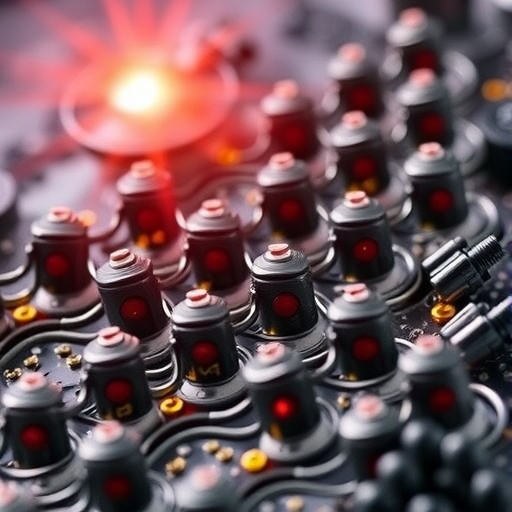In a groundbreaking advance that challenges longstanding conventions in materials science, researchers at Stanford University and their international collaborators have unlocked a tantalizing new frontier for iron-based electrode materials. Building on initial insights from a 2018 doctoral thesis, the team has demonstrated an iron-based cathode capable of undergoing redox transitions involving five electrons per iron atom—far surpassing the previous ceiling of three electrons. This discovery holds enormous promise for dramatically enhancing the energy density and voltage of lithium-ion batteries, with potential ripple effects across a spectrum of technologies reliant on magnetic or superconducting materials.
Historically, the redox chemistry of iron in battery cathodes has been constrained by the metal’s tendency to participate in oxidation-reduction processes with a maximum valence change involving two or three electrons. This limitation restricts the attainable energy storage capacity inherent to iron, which ironically remains one of the most abundant, cost-effective, and environmentally benign transition metals. The potential to push iron into higher oxidation states and reverse these changes in a stable, repeatable fashion has been a coveted goal—one that had remained elusive due to structural instabilities and unwanted side reactions within the materials.
The pivotal breakthrough emerged from the collaborative effort spearheaded by Stanford PhD candidates Hari Ramachandran, Edward Mu, and Eder Lomeli, who meticulously refined the synthesis and characterization of a new lithium-iron-antimony-oxygen (LFSO) cathode material. Their team hypothesized that spatial separation of iron atoms within the host crystal structure would prevent deleterious oxygen bonding and other side reactions, thereby enabling iron to reversibly lose and regain as many as five electrons. The crux lay in engineering nanoscale particles—mere hundreds of nanometers in diameter—far smaller than previous attempts. Such nano-dimensions stabilized the crystal framework during charge-discharge cycles, a feat previously unattainable.
Their approach involved growing nanocrystals from an intricate liquid medium solution, a technically challenging process that required balancing complex chemical interactions to yield uniformly small and stable particles. Electrochemical testing confirmed that the LFSO cathode maintained structural integrity and exhibited reversible redox activity consistent with the unprecedented five-electron transition. However, this apparent expansion of iron’s electronic shuttling raised critical questions about the underlying electronic structure.
To unravel the atomic-level nuances, the team incorporated advanced spectroscopic techniques combined with theoretical modeling. Collaborator Lomeli, leveraging state-of-the-art numerical simulations at SLAC National Accelerator Laboratory, discerned that the additional electrons were not sourced solely from iron atoms but instead involved a cooperative interplay between iron and surrounding oxygen atoms within the crystal lattice. This emergent behavior exemplifies a sophisticated collective electronic structure, where iron and oxygen participate as a unified redox entity rather than independent actors—a conceptual leap reflecting the complexity and subtlety of transition metal oxides.
The implications extend beyond battery technology. The team envisions applications in fields dependent on iron’s magnetic properties, such as magnetic resonance imaging (MRI) and magnetic levitation systems, and even anticipates ramifications for high-temperature superconductors, where electron transfer dynamics are critical. The broader material science community has long sought sustainable alternatives to cobalt and nickel—metals that dominate current lithium-ion battery cathodes but pose supply chain vulnerabilities, geopolitical concerns, and ethical issues linked to mining practices in regions with problematic labor conditions.
Iron-based cathodes, particularly those combining lithium, iron, phosphorus, and oxygen, already comprise about 40% of global lithium-ion battery cathodes due to their lower cost and more sustainable sourcing. Yet, these iron-phosphate cathodes are inherently limited by relatively low operational voltages. A high-voltage iron cathode that leverages reversible FeIII/V redox activity could revolutionize battery design, overcoming the tradeoffs that have forced manufacturers to rely on costly and ethically challenging metals to achieve higher voltages.
Structurally, the LFSO nanoparticles distinguish themselves by their ability to accommodate lithium extraction without catastrophic lattice collapse. Conventional bulk iron-based cathodes tend to exhibit irreversible twisting and fracturing upon lithium migration during battery charging. By contrast, the nanoscale LFSO material exhibits elastic bending, effectively absorbing mechanical stresses and preserving its structural coherence through multiple cycles. This resilience is critical for practical commercial deployment, where longevity and reliability are paramount.
The team’s integrated methodology combined rigorous experimental electrochemistry, spectroscopy using X-rays and neutrons at prominent national laboratories across the United States, and sophisticated computational modeling. This holistic approach enabled them to move beyond mere empirical observation to a deep understanding of the microscopic processes enabling the five-electron redox cycle. The research underscores the power of interdisciplinary collaboration spanning physics, chemistry, materials science, and engineering.
Despite the monumental progress, a key challenge remains: antimony, a component of the LFSO cathode, shares some of the supply chain and cost concerns familiar to cobalt and nickel. The Stanford-led team is actively exploring alternative dopants and compositional tweaks to substitute antimony without sacrificing the essential electrochemical properties. Such efforts are critical to transitioning this discovery from laboratory curiosity to industrially viable technology.
This research heralds a new era of sustainable energy technologies leveraging the earth-abundant and environmentally favorable element iron. By shattering previously accepted electrochemical limits, the findings open the door to higher performance lithium-ion batteries that could accelerate the adoption of electric vehicles, grid-scale energy storage, and innovative magnetic and superconducting devices. As the scientific community continues to refine and scale these materials, the dream of affordable, durable, and powerful iron-based energy storage moves closer to reality.
Subject of Research: Not applicable
Article Title: A formal FeIII/V redox couple in an intercalation electrode
News Publication Date: 15-Oct-2025
Web References: http://dx.doi.org/10.1038/s41563-025-02356-x
Image Credits: Bill Rivard
Keywords
Lithium ion batteries, Chemical engineering, Chemical physics, Electrochemical energy, Electrochemical reactions, Sustainable energy, Materials engineering, Materials science, Sustainability




